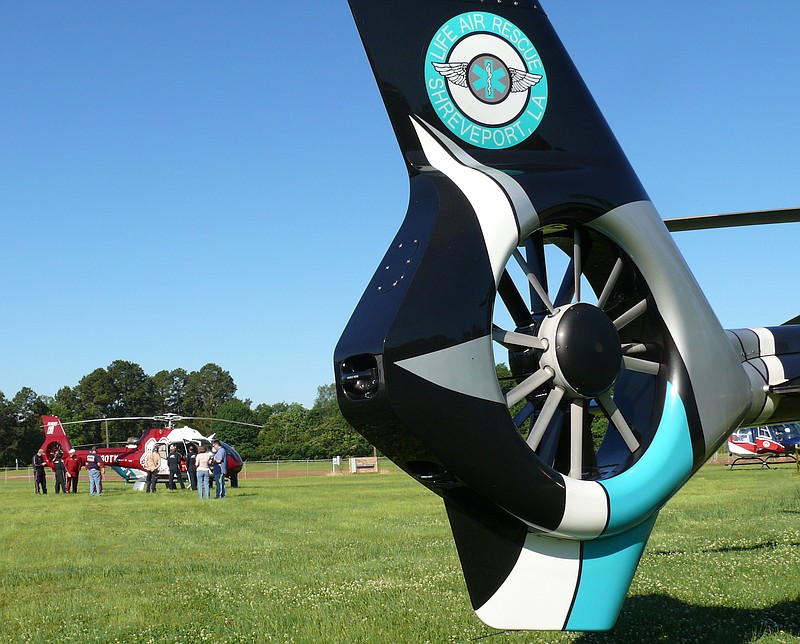The volunteer firefighters may be young and new but, still, soon they will be dispatched to a serious accident.
Once there, they must help the victim, and helicopters are flying in. It's dark. The area's a bit strange. Will the volunteers know what to do?
They will if they have been part of the Douglassville Volunteer Fire Department's and Fire Chief Alfred Point's Landing Zone School, just having finished its 11th year of training.
On Saturday morning, four emergency medical helicopters flew into the field behind the Atlanta Fire Department station, which once was the Atlanta High football stadium, to participate in the school.
Here those copters, as in rescue operations, had to be landed, cared for safely and used to successfully accomplish their mission. That mission is saving human lives.
The rescue-centered goal is called achieving the "Golden Hour." That is, being called to an accident, assessing its impact, launching a multi-million dollar medevac helicopter with its superbly trained crew. Then guiding that copter to a safe landing, helping it load and getting back into the air with the accident victim, and arriving at the appropriate medical center-all within one hour.
When there's more than one accident victim, more than one helicopter will be needed. Six are available in this general area, Chief Point said.
"That's wonderful, and we're ready. We're well-served, and we're well-trained," he said of his own 32 years of leadership as a volunteer and landing-zone coordinator.
But landing and caring for those four helicopters is amazing. That's why it takes training, both on the ground and in the air.
Here's one exampl: Did you know the helicopter pilot cannot see power lines even in daylight, let alone at night, from flying height?
So, on the ground, Point will have a piece of firefighting equipment, such as a tanker truck, stationed under the lines with its nose pointed at a nearby telephone pole or other obstacle.
He will already have been talking to the pilot by radio from its launch out. Now his eyes will be focused totally in coordination with pilot's eyes to guide that copter in.
Nobody will get past that 100-by-100 feet landing zone. Ground control guards will be at the 'copter's nose and rear. No one, not an excited family member or even a wild animal is going to get near the copter.
"If that helicopter were to hit a power line, snap it and start swinging it around, do you imagine what that whip power might do?" Point noted.
Helicopters themselves, while strong and powerful, are still light, made of aluminum and titanium. Their rotors can create a hurricane-gale force. They can turn over. And only trained firefighters can fight a helicopter fire. Not the casual helper with a fire extinguisher.
Fortunately, in Point's 32 years here, there's not been an EMS helicopter accident.
The helicopter comes 24/7
under most conditions, although weather sometimes prevents their flying. And volunteers on the ground serve 24/7 in all kinds of conditions, too. Ground medical transport, law enforcement, firefighters, emergency personnel, TxDOT personnel-they all come.
Here's a fact that recently astounded Point:
"In a Dallas newspaper, it was reported 75 percent of the fire departments in the state of Texas are volunteer," he said.
In Cass County, Fire District 1 in McLeod and Fire District 2 in Queen City are supported with tax money and the Atlanta Fire Department relies on city funds. That's three of 13 departments in the county, he noted.
"We get little funding from the county and live off donations. Yet we get more and more calls. A volunteer fire department has to have someone around all day, everyday, someone old like me. It's gotten demanding, but I love it. I retired from the Texas Department of Transportation so that I could do this," he said.
Helicopters and emergency medical services that came to the landing school here included:
- Life Air Rescue out of Shreveport, EC-135
- Flight For Life, Champion EMS out of Longview, EC-135
- Air Evac Lifeteam 73 EMS out of DeQueen, AR, Bell 206
- Air 1, East Texas Medical Center out of Pittsburg, EC-130
Today, helicopter landings are part of the tactical firefighter's skill. Landing Zone School is required. The training here included two hours of continuing education credit for both first-time and veteran emergency careworkers. About 75 attended.
The Douglassville VFD landing zone school, while the main and central school for the region, is not the only one. TxDOT gives one school each year for its own employees and others. Point leads that one, too, which draws about 25 participants each year, he said.
CHRISTUS St. Michael Health System prepared the noon lunch for all EMS workers present while the Atlanta Fire Department provided facilities and other assistance.
Helicopters are unique flying machines. They may drop down on highways, parking lots or the middle of a busy intersection. They hover, land and take off vertically yet create powerful excitement and hurricane-like winds.
Their biggest mission is saving human lives. Yet, for all the lives they save, helicopters can still be a dangerous machines. Universally accepted procedures for their care must be trained, practiced and followed.
"We are well-trained," Point said again.
And as for the helicopter pilots and crew he works with?
"They are lovable people. Never met one who wasn't. They love their work and are full of personality. I can say that for them."


